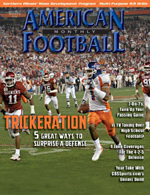Article CategoriesAFM Magazine
|
Speed Report: What’s Often Overlooked When Teaching Football Speed Skillsby: Dale BaskettFootball Speed Specialist © More from this issue Biomechanics, physiology and motor learning must blend together and not be looked at as separate bodies of application. My objective for this article is to bridge the gaps between certain aspects of training norms and application considerations that are often not used collectively. Training for speed and movement must have greater understanding as to why effective techniques are effective. In this article we’ll discover why many coaches experience difficulty in teaching the key aspects for speed and movement development.
|
|
|||||||
| HOME |
MAGAZINE |
SUBSCRIBE | ONLINE COLUMNISTS | COACHING VIDEOS |
Copyright 2025, AmericanFootballMonthly.com
All Rights Reserved





